How to wash, dry, and care for blankets and throws – our ultimate expert guide to avoid damage and musty smells
Freshen up and store your blankets to perfection with professional insight

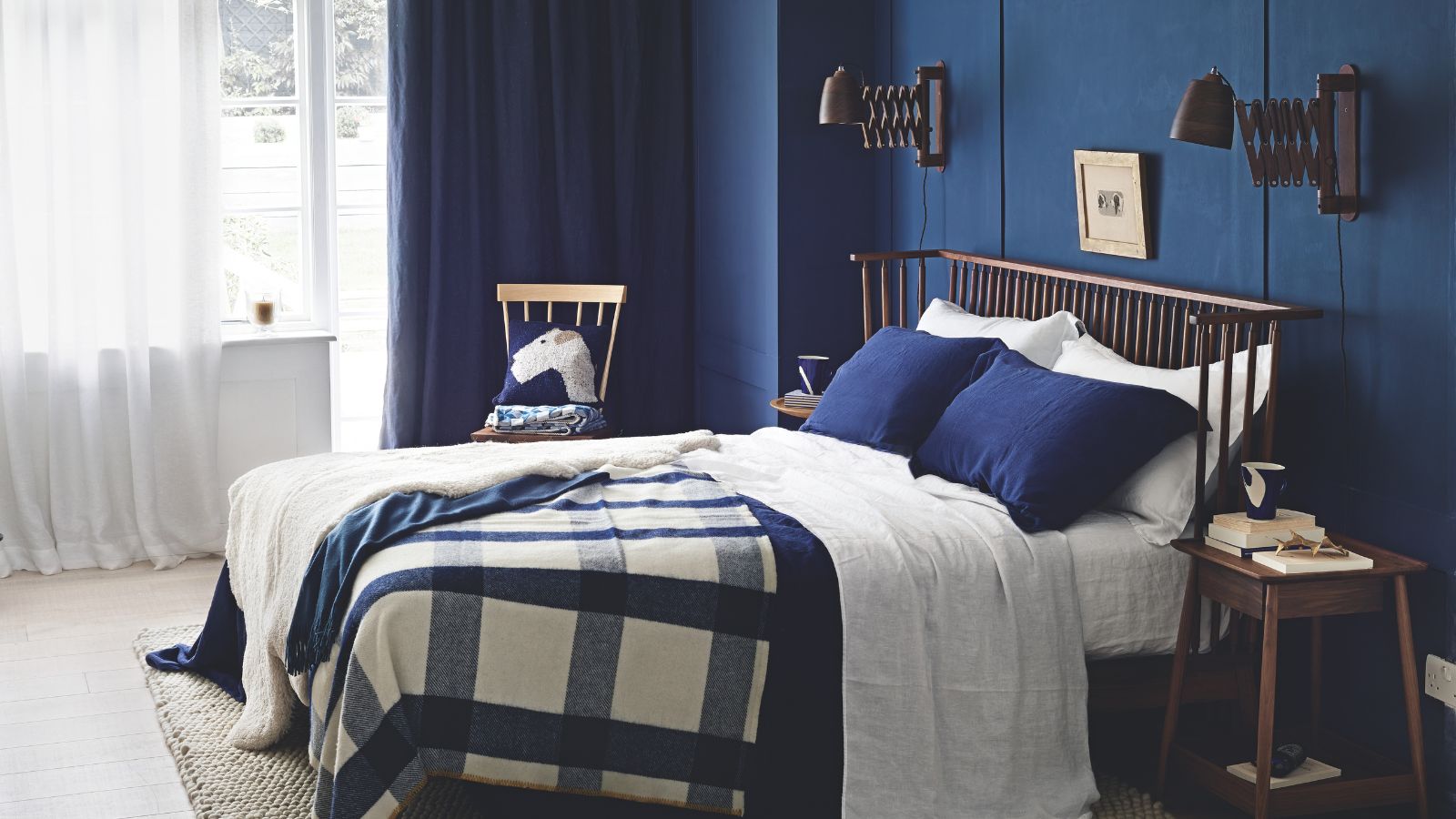
They'll be found in any chic and cozy home as the weather cools – but do you know how to wash, dry, and care for blankets and throws?
Getting this care right is important if you want to keep your covers soft and sumptuous, lasting for seasons to come without pilling or damage. Importantly, advice varies based on the type of blanket or throw you're freshening up, folding, or storing; be it fleece, sherpa, weighted, or woolen.
Here's our ultimate guide to looking after the best throw blankets out there, for unbeatable comfort and longevity throughout the snowy seasons and beyond.
How to wash and dry different types of blankets – expert advice for each kind
Washing fleece blankets
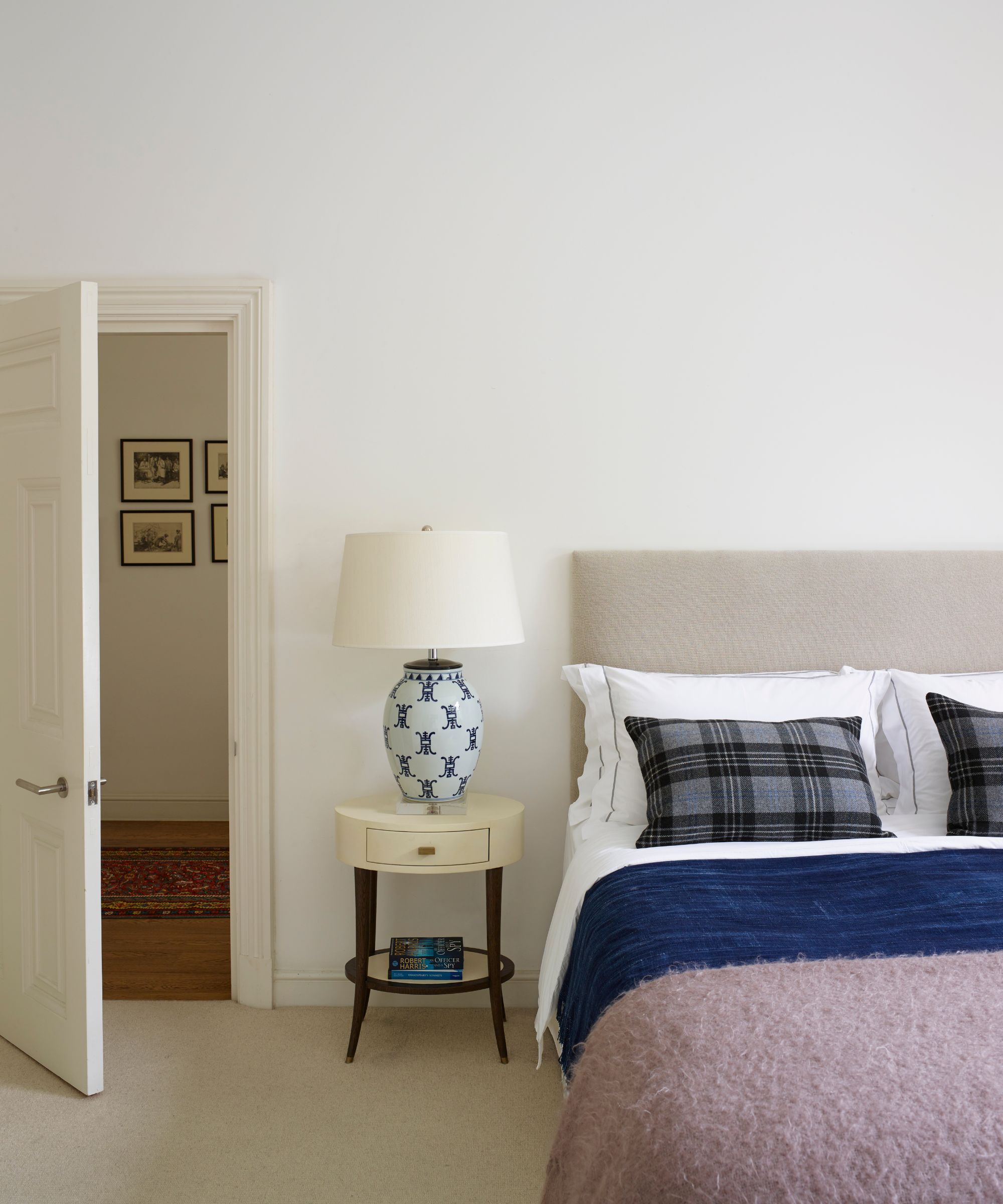
Fleece blankets are soft, warm, and lightweight, but it's important to wash them correctly
Fleece blankets are among the most common, affordable types of blankets, and are therefore found in most homes. They're versatile and cozy, made from synthetic fibers that are soft, warm, and lightweight. This makes them an ideal choice for snuggling up on the couch on a cooler evening, or adding an extra layer of warmth to your bed.
Here's how to wash fleece correctly:
- Check the laundry symbols on the care instructions: As Parveen Garg, manager at Ola Clean says, 'This will guide you on the appropriate washing temperature, detergent, and any other care considerations.’ Fleece blankets can be delicate, so using a gentle or delicate cycle is the best option. This will help prevent any damage to the fabric while still effectively cleaning it. Place the fleece blanket inside a mesh laundry bag, available at Amazon, before tossing it into the washing machine. This extra layer of protection helps prevent any potential snags or tears, and is also best recommended when washing, drying and caring for bed linen, too.
- Use a mild detergent and low heat: When washing your fleece blanket, Shayne Jeramos, a cleaning specialist from Bright Cleaning Services, suggests using a milder detergent specifically designed for delicate fabrics, such as the Woolite Delicates Hypoallergenic Liquid Laundry Detergent, available on Amazon. Harsh detergents can damage the fibers of the fleece and leave behind residue that can irritate your skin. Opting for a gentle, hypoallergenic detergent will ensure your blanket stays soft and cozy. Additionally, fleece is known for its ability to retain heat, so washing it in hot water can cause it to shrink or lose its softness, which is why it's an item you should never wash in hot water. Washing fleece in cold water will not only help maintain its softness but also save energy and prevent any color fading. The same applies when washing, drying and caring for comforters and duvet inserts, too.
- Steer clear of fabric softener: Another important note is that washing fleece blankets is a time you should never use fabric softener in laundry. Although they may seem like a great way to keep your fleece blanket extra soft, they can actually do more harm than good, leaving a waxy buildup and unpleasant odor behind. It's best to use dryer balls, available at Amazon, instead, which can help reduce static cling without leaving behind any residue that might affect softness.
- Air-dry or use low heat: Once washed, it's best to either air-dry your fleece blanket or tumble-dry it on a low heat. High heat can cause the fibers to melt and shrink, leaving your blanket misshapen and stiff. ‘Before placing the fleece blanket in the dryer, give it a good shake to remove any excess lint or hair,’ says cleaning specialist Janille Mangat from VMAP Cleaning Services. ‘This helps prevent these particles from accumulating during drying. Air drying is the gentlest method for drying fleece blankets.’ Avoid ironing your fleece blanket, as the high temperature can melt the synthetic fibers and ruin its texture. If you need to remove wrinkles, simply shake out the blanket or use a fabric steamer, such as the HiLIFE Steamer available at Amazon, on a low setting.
- Spot clean stains: For small stains or spills, spot-clean the affected area with an enzyme-based mild detergent and a smooth-bristled brush, rather than washing the entire blanket. This can help maintain the overall cleanliness of the blanket between thorough washes.
Washing sherpa blankets
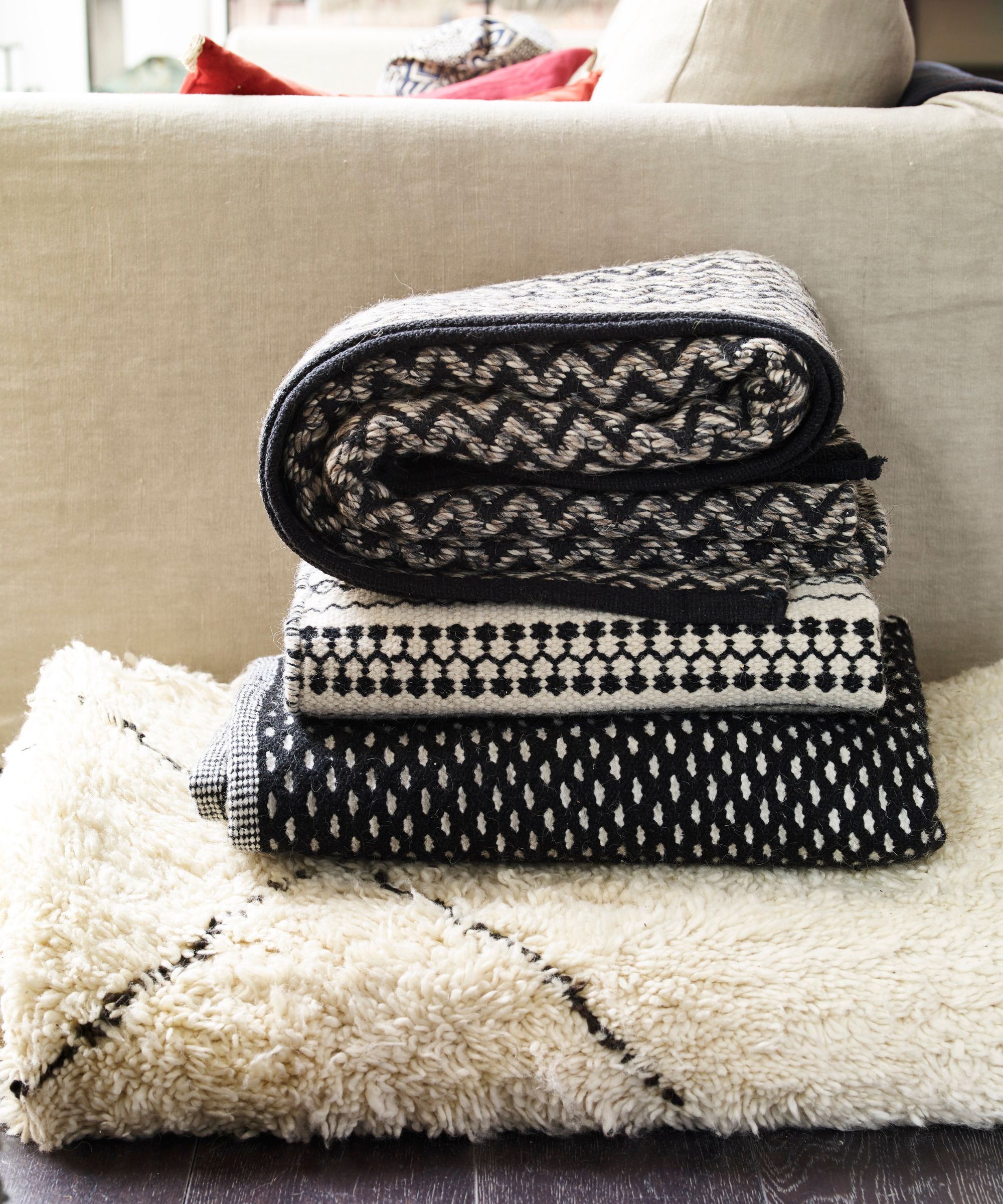
Washing sherpa incorrectly can ruin its fluffy texture
Sherpa blankets are the epitome of coziness. Their fluffy texture and super warm properties make them perfect for snuggling up for long nights on the sofa. But how do you wash a sherpa blanket without ruining how glorious it feels? Our pros say it all comes down to knowing how to do laundry with delicate textiles. Here are the steps experts recommend:
- Check the laundry symbols: As Barbara Stern, textiles expert at Ottoman Textiles says, 'The blend of gentle washing, mindful product selection, and appropriate drying methods will not only ensure the longevity of your cherished sherpa blanket but also retain its inviting softness and cozy allure.’
- Stick to spot cleaning when possible: When it comes to delicate fibers such as sherpa, spot cleaning should be your go-to step before you consider throwing it in the washer, says Muffetta Krueger, cleaning expert and founder of Muffetta’s House Cleaning. ‘If there are specific stains or spills, it's a good idea to spot-clean them first. Use a mild detergent and water to gently clean the affected area. Avoid harsh chemicals that can damage the fabric,’ she recommends. Spot cleaning regularly and as needed will stretch the time between washes, she adds. This can help to preserve the fluffy texture.
- Use a delicate cycle: Although sherpa is not so delicate that it requires hand washing, it is essential to use a delicate cycle when laundering this type of fabric, Barbara advises to preserve its softness and reduce static and friction in your machine. She adds, ‘For an added measure of fabric care, consider using a detergent designed for delicate fabrics.’
- Avoid fabric softeners: Again, the presence of silicones can stiffen the soft fibers of your sherpa and cause damage. ‘Instead, opt for natural alternatives like using white vinegar in laundry in small quantities, which helps soften the fabric without causing damage,’ suggests Tadas Pukas, CEO and founder of Minimalistic Linen.
- Don't overload the machine: ‘It is so important that you don't overload the washing machine – especially when treating sherpa,’ says Muffetta. ‘Overcrowding is a common bedding laundry mistake that can cause friction and lead to matting of the sherpa fabric. It's better to wash the blanket on its own or with a few other soft items.’
- Air dry only: There are several benefits to air drying your laundry. Lina DaSilva, cleaning expert and founder of Toronto Shine Cleaning, always chooses to air dry blankets to help maintain the soft texture. This is because, even when using the delicate setting on a tumble dryer, high heat can melt the fibers, resulting in a rough finish that is far from comfortable to cuddle up with. Then, Lina suggests laying the blanket flat on a drying rack, like this from Amazon, to allow it to dry fully without stretching. You can use your best dehumidifier to help aid the drying process, too, if you don't want to wait around.
Washing woollen blankets
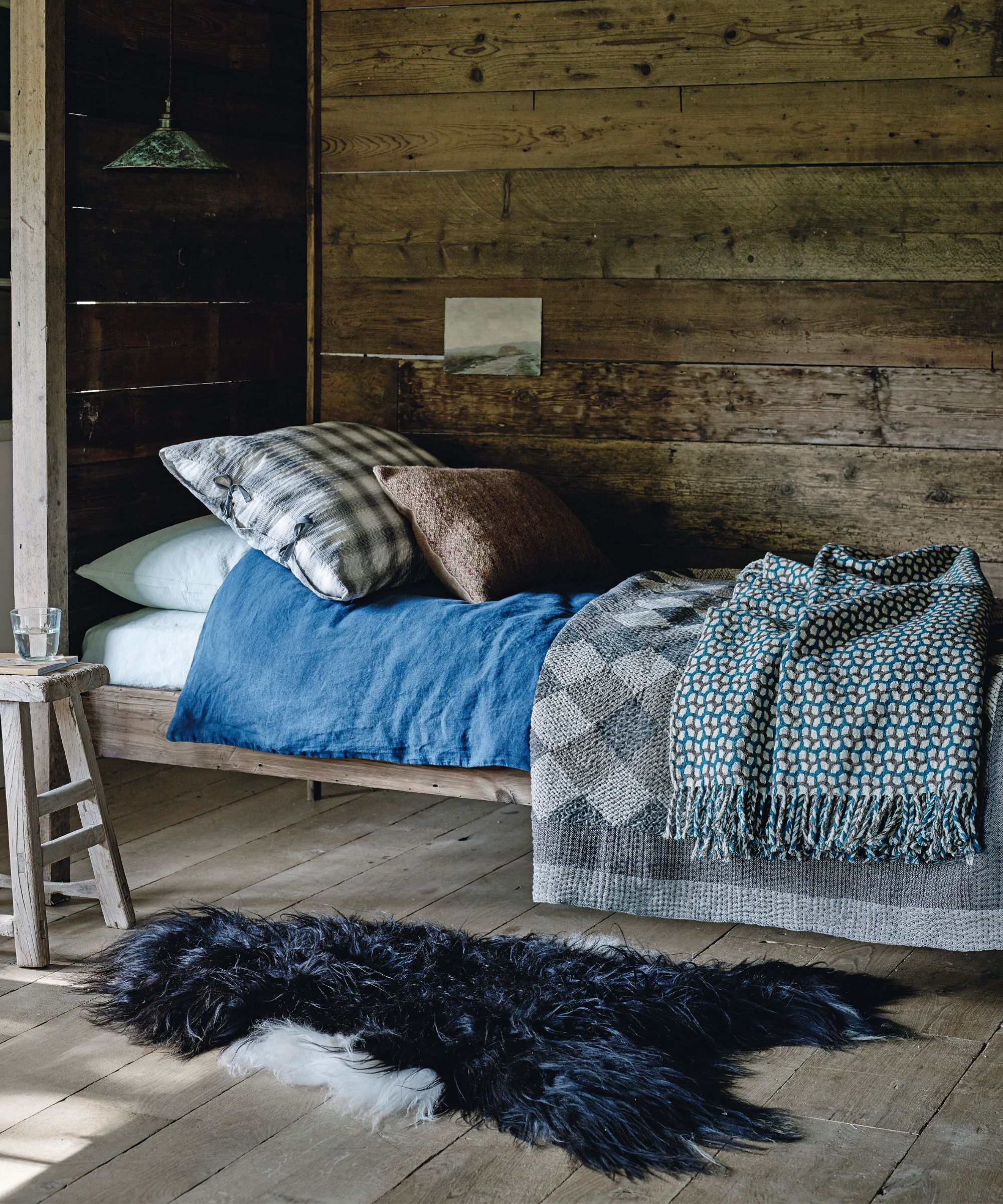
Maintaining this natural fabric can be tricky
The right washing and drying methods and techniques can make wool blankets pristine once more without compromising softness. Many can be put into the washing machine, although some will need cleaning by hand.
Design expertise in your inbox – from inspiring decorating ideas and beautiful celebrity homes to practical gardening advice and shopping round-ups.
Here's our expert advice on washing wool:
- As always, check the laundry symbols
- Select a cool temperature: Most woollen blankets will recommend a cold temperature setting, on the woollen or handwashing cycle. ‘All Miele washing machines have a dedicated woollens/handwash programme which incorporates a specialised drum rhythm to deliver the gentle care woollen fabrics need,’ says Sophie Lane from Miele. She also recommends adapting the spin time to allow for a gentler cycle.
- Use a suitable detergent: ‘Before you start, make sure you have a delicate detergent designed for wool or silk fabrics,’ says Sophie. We recommend The Laundress Wool & Cashmere Shampoo available at Amazon as it's specially made for washing this type of blanket material, and is Climate Pledge Friendly, with the manufacturer using the least amount of packaging possible and a double concentrated formula to reduce water usage and make it as efficiently transportable as possible.
- Hand washing: If it is not suitable for the washing machine, you can hand wash a woollen blanket instead. This is often the preferred method as there’s little to no risk of damage. ‘I find hand washing is usually best for woollen items,’ says Lina Bombova, a TaskRabbit tasker specialising in cleaning. ‘Try soaking the blanket in cool water for a few hours with a very gentle woollen detergent,’ she advises.
- Removing stains: Whilst wool is known to be naturally stain resistant, the best way to deal with a stubborn mark on a woollen blanket is to tackle it quickly. For greasy stains, use a hot iron over a few layers of tissue to blot up any excess grease, then soak a cloth in white spirit and gently dab the area. Remove milk stains using a mixture of salt and tepid water. Most other stains can be tackled with a gentle mixture of detergent and water. Dry all on-the-spot stains by pressing gently with a microfiber cloth, such as the bestselling Great Value Microfiber Cleaning Cloth available at Walmart. Do not rub in circles as that will push the liquid further into the wool.
- Drying: Most woollen blankets must be air-dried to protect the delicate fibers in the material. Re-shape the blanket whilst still damp, preferably on a flat, clean surface, then hang to dry. Mihalis Dimopoulos, founder of New York-based company, Lazy Susans Cleaning Service, advises, ‘Hang it outside, out of direct sunlight. Sunlight can fade the delicate colors in wool, and it may cause wool to dry too quickly, making it very coarse,’ he says. Good quality woollen blankets and throws can be an expensive investment, so it’s worth washing and drying before you pack them away for the summer. Careful maintenance will ensure your soft fabric wool blanket lasts for years to come.
Weighted blankets
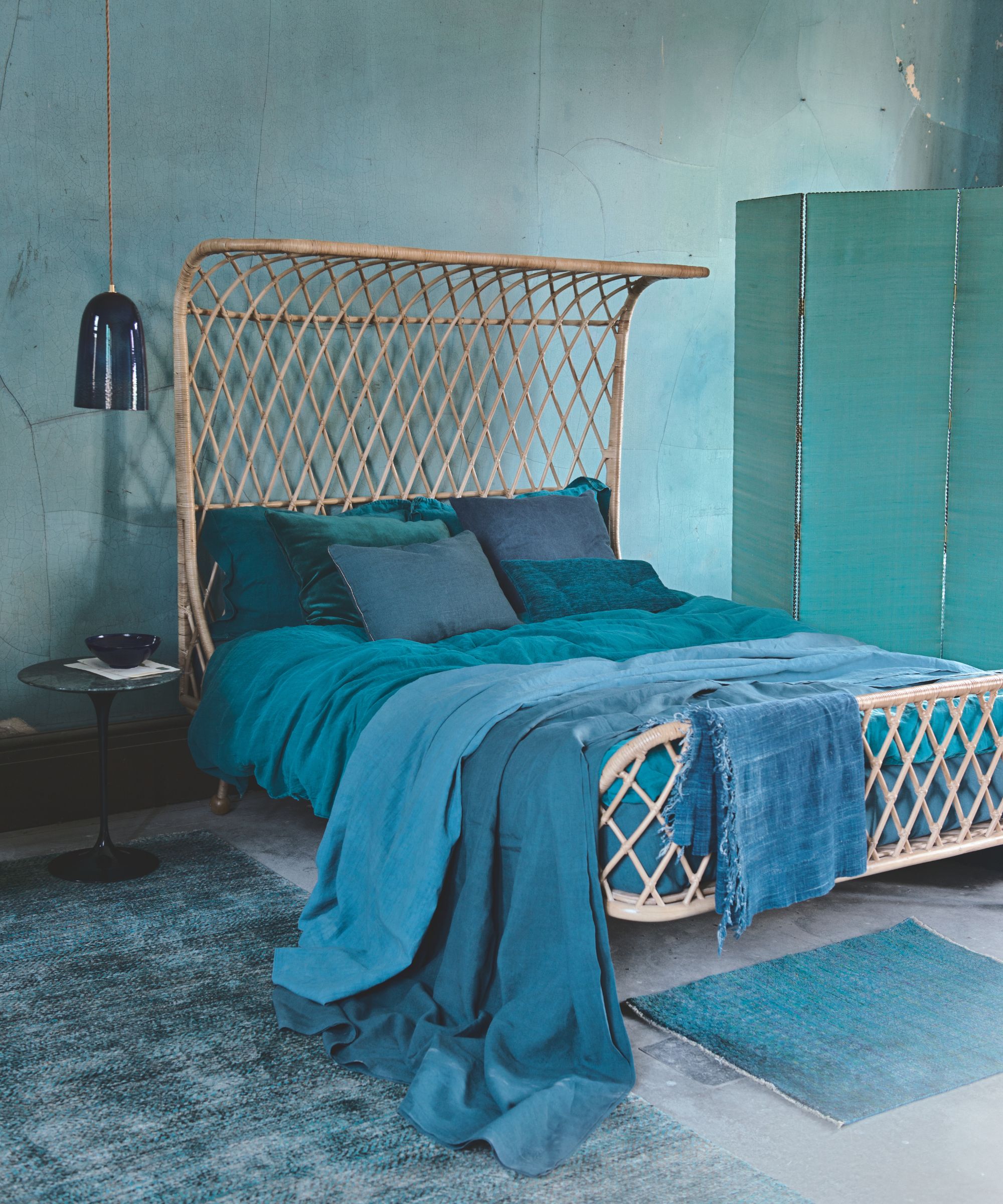
Weighted blankets require specific care and considerations
Many of us are convinced that our weighted blankets improve the quality and quantity of our sleep, but are left puzzling about how to keep them fresh. If you've fallen for its supreme calming comfort, this is how to wash your weighted blanket without damaging it, or ending up with a mildewy smell ruining the comfort.
Just as with other bedding, cleaning a weighted blanket regularly is necessary so it stays hygienic. But because it is a heavier cover, washing it isn't as straightforward as it is for the other cozy bedding and throws.
Here's the advice necessary for washing a weighted blanket, whether your laundry room ideas have made space to do so at home, or you’re taking it to the laundromat:
- Assess the weight: Knowing how to wash a weighted blanket correctly involves an assessment of the blanket’s actual weight. This will determine whether you can put the blanket into your washing machine at home or if you need to take it to the laundromat instead. Jessica Samson, a cleaning expert at Maids, advises, ‘In your washing machine, you can wash almost any weighted blanket up to 20 lbs. Any weighted blanket heavier than this, you should wash at the laundromat with a commercial machine.’ The washer needs to have a large enough capacity, so exercise caution. Wayne Edelman, CEO of Meurice Garment Care suggests, ‘A good rule of thumb is to only fill the machine two-thirds full with the item being washed.' The type of washing machine you own is also important. ‘I only recommend using a front-loading machine to wash weighted blankets,’ says Wayne. Some may have a removable outer cover, in which case you won't need to worry about the weight at all. To figure out the weight of your blanket, weight yourself, then weight yourself again holding the blanket. The difference between the two numbers will tell you the weight. Otherwise, check your emails for the order details if you bought it online, or check the retailer's website to see if it's still available, as they will list this information.
- Check the care instructions: Just as when washing pillows, or washing electric blankets or washing woollen blankets, check the tag for the manufacturer’s washing instructions. As Jessica says, ‘Blankets weighted with glass microbeads or plastic pellets are usually washer safe, but be sure to check the label before washing.’
- Treat stains before washing: Before putting a weighted blanket into the washing machine, inspect it for stains so you can deal with them first. ‘Pre-treat your blankets before washing them,’ says Jessica. ‘This will help eliminate any stains on the weighted blanket and help you clean it thoroughly.’ We recommend the Resolve Multi-Fabric Cleaner and Upholstery Stain Remover available at Amazon for this. Importantly, allow time for this process. ‘Be sure to leave the stain remover on the blanket for at least 10 minutes to help break down and loosen the stains,’ adds Jessica. ‘After letting it soak for 10 minutes, gently dab the area with a paper towel and lift the cleaner and the stain. Try to remove as much of the stain as possible without rubbing it in. If done right, the washing machine will do the rest.’
- Add the detergent: When it comes to how to wash a weighted blanket, choose the detergent carefully. ‘Use a gentle detergent without bleach,’ says Wayne. You might be tempted to add fabric softener, but step away. Fabric conditioner should not be used when washing a weighted blanket.
- Select a gentle, warm cycle
- Dry: Check the label first, but you can likely use a dryer if this is your preference. ‘Most of these blankets can be dried in your dryer on low heat, or you can let them air dry,’ says Jessica. If the weighted blanket is going into the dryer, it’s worth checking its filling periodically during the drying cycle in case it has become bunched up. ‘Remove and redistribute as necessary,’ says Wayne. As with washing, the dryer must have sufficient capacity. Follow the two-thirds rule as you did when assessing the size of the washing machine drum, and take any 'Dry Clean Only' options to the dry cleaners. For air-drying your weighted blanket, lay it flat on a rack or on a water-resistant surface such as a laundry room countertop to ensure equal weight distribution. Avoid hanging up your blanket as the filling may fall to the bottom, causing problems when you try to redistribute it later.
How to fold blankets neatly to avoid damage in storage

Washing, fully drying, folding and storing your blankets in warmer weather will protect them from dust, pollen, spills and keep them fresh.
Knowing how to fold blankets so they remain neat, tidy, and in great condition is a useful skill to have. It'll also help organize living rooms and declutter bedrooms in the warmer months when those extra layers are not needed.
There are a few different folding techniques you can use. Depending on the size and texture of your blanket, as well as where you're planning to store it, some are better than others.
- The square method: If you’re storing blankets on open shelves, or as part of organizing a linen closet, the square method is your best bet. It's really quick and simple, too. Lay the blanket flat and smooth out the creases, before folding it into thirds lengthwise to create a long, thin rectangle shape. Then, fold the length in half (and half again if necessary) to create your desired square shape. Shannon Krause, professional organizer of Tidy Nest, advises, 'Regardless of what folding technique you’re using, if your blanket has a fringe along the edge, try and tuck it inside the initial fold so it doesn’t get damaged or hang off the edge of the shelf.'
- The pillow, or envelope, method: If you’re wondering how to roll a blanket into itself so it won’t unravel, this is the method you’d use. As its name suggests, it forms a neat ‘pillow’, making it a clever way of adding blankets into the room without overdoing it on layers. Start in the same way as with the square method; lay the blanket flat and smooth out the creases. Fold into thirds lengthwise to create a long, thin rectangle. Then, take a short edge and start to fold towards the opposite edge, stopping when you’ve created a fold around the size you want your finished ‘pillow’ to be. Keep folding the rectangle over itself until you’ve created a thick parcel. Leave a bit of the blanket unfolded at the end to create a ‘pocket’. Stuff the folded blanket inside the pocket to create a neatly contained ‘pillow’.
- The rolling method: Stylish and easy to access, large open storage baskets make the perfect vessel for storing blankets when they’re not in use, and a neat stack of nicely-rolled blankets makes for an aesthetically pleasing display. Even if you’ve opted for a lidded design, rolling blankets is still worth doing. Not only is it space-efficient, but it’ll keep them neat – using a blanket full of creases will make any room feel untidy. Shannon advises a similar approach when learning how to roll towels. She says, ‘Fold the blanket in half lengthwise so both halves are aligned. Repeat this so you have a small rectangle. Flatten out the fabric to remove any wrinkles. Start at one end (either of the shorter sides of your rectangle) and tightly roll the blanket.'
How to store blankets to protect them from dust and reduce your clutter

Make sure to store blankets in a cool, dry place
Blankets keep us warm and help keep our spaces feeling cozy, even after the holidays. It's hardly a surprise, then, that many of us end up with an extensive collection and find ourselves wondering how to store them properly so that they stay looking good and feeling fresh.
So where can we place them when they aren't in use? Especially if you do not have a linen closet or if your living room storage is at its full capacity. Luckily, the experts have some tricks up their sleeve, but make sure your blanket is washed and fully dry before storing:
- Keep them decoratively accessible with trunks, baskets, and coffee tables: Start by keeping your collection of blankets thoughtfully curated, and if you are wondering whether you have one too many, it may be wise to use the start with enough method to make your new blanket storage ideas less crowded. Once you've reduced your collection to only what you need, it's time to embrace dual-use furniture. Consider trunks filled with throws that act as coffee tables or seats. Professional home organizer and TV personality Janelle Lam tells us that the best place for storing blankets in the home is where remain within reach. 'If you have throw blankets, I recommend putting them in a decorative storage basket near where you use them, like your couch,' she says. Likewise, interior design expert and the founder of Arsight Studios, Artem Kropovinsky, suggests we lean into the art of disguising our blanket storage stylishly. 'Secret storage with an iota of vintage can be achieved with ornate trunks, such as the Texture Brand Trunk available at Wayfair, and stylish baskets,' he recommends.
- Make a display of throws using wall space: This next tip is perfect for conserving floor space. Make the most of the space in a small living room or bedroom by leaning into 'towel racks' – ripe for the elegant draping of blankets. 'You can use ladder-style racks for a sophisticated presentation,' Artem says. Spare, good-looking blankets can enhance a room and make it look more inviting. Even those who prefer minimalist decor ideas can explore this option. Choose simple wall fixtures, like hooks or wall-mounted rings, and neatly drape blankets in as elegant a fashion as you can to capture the warm minimalist trend at its best.
- Bring them into your bedroom ottoman: A wonderful, not-so-well-kept bedroom storage idea secret is an ottoman at the foot of the bed. This design feature is endorsed by many for bedding and bedroom essentials, not to mention a cozy additional seat. If you find most of your blankets in the bedroom, or if you are short on space elsewhere, this is a fine option.
- Store seasonal throws under the bed: Ottomans are not the only place where blankets can discreetly reside in the bedroom. If you have no linen closet and have maxed out the storage space in a small home, slot surplus throws strategically under the bed. Julianna Melamed, Founder of Full Service Living, recommends. 'If it's not a blanket for everyday use, and you have space under the bed, I would purchase canvas under-bed storage containers and store your blankets there.' Storing this item under your bed will not disrupt Feng Shui either. Of course, you need to reduce their size first, and for this, grab your vacuum. 'If these are seasonal blankets, I would purchase a vacuum seal system and store the compressed blankets deep under your bed,' recommends Julianna. 'After all, you won't require them again for a few months.' These are Julianna's favorite under-the-blanket storage boxes on Amazon, which also help to protect against dust and insects. 'They have clear tops so you can see everything, and the handle is around the entire perimeter for an easy grab, no matter how deep under the bed,' she says.
According to cleaning specialist Prerna, you should also store your blankets in a cool, dry place. Avoid direct sunlight and damp areas, as they can cause the color to fade and mold to develop.
Maintain your fleece blanket's softness by giving it a quick brush after washing and drying. Use a soft-bristle brush from Amazon and gently brush in the direction of the fleece. This will keep it fluffy and prevent matting.
What to shop
All prices were correct at the time of publication.
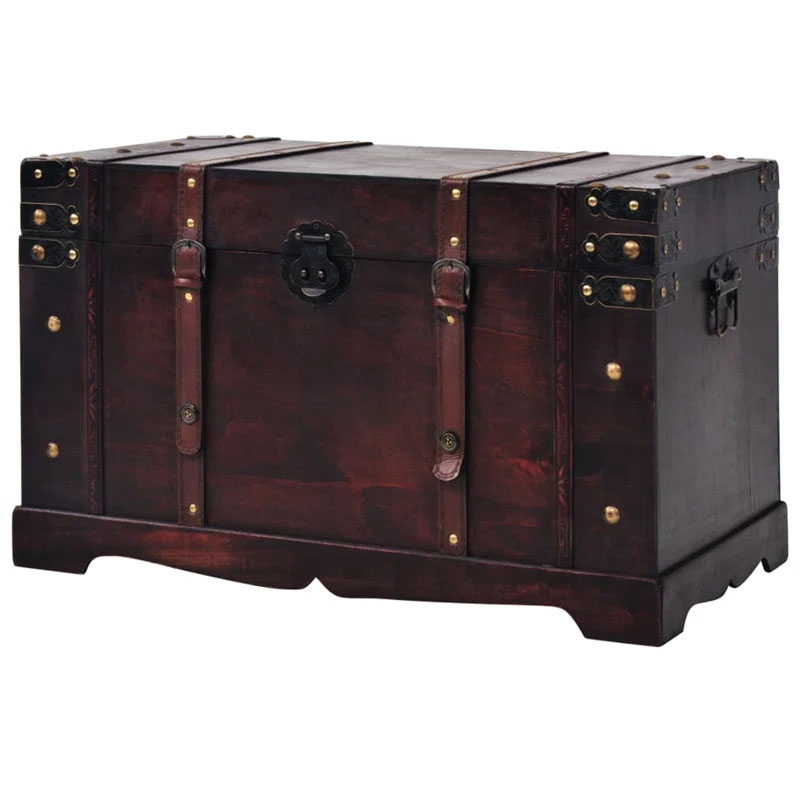
This beautiful, solid wood trunk is designed to bring character to a modern or traditionally decorated home and will house your throws with ease when not in use.

An ideal living room addition that will happily hold blankets and any surplus of your best throw pillows, too.
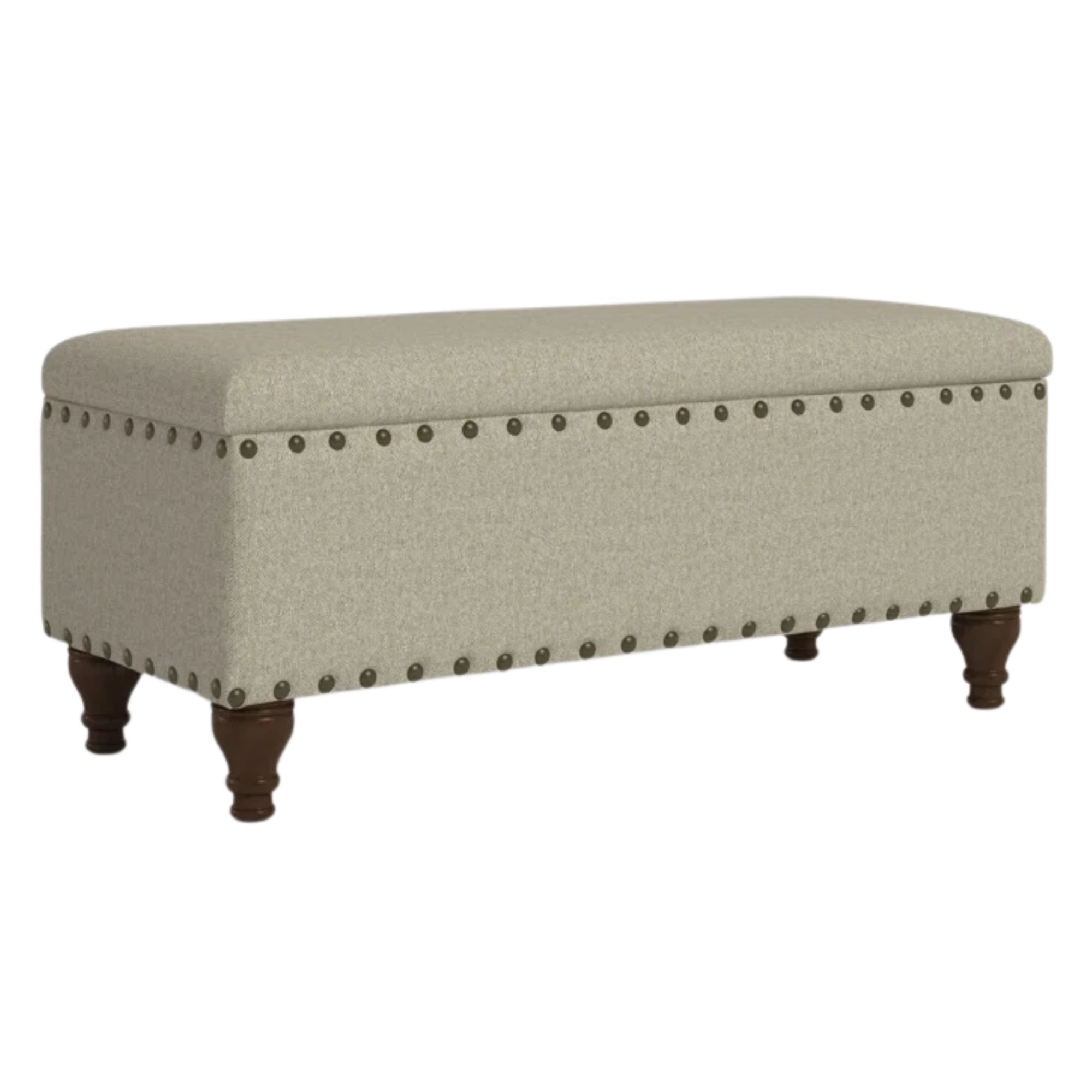
Add style and spacious storage to any living room with this ottoman, which has a 250 lb weight capacity and plenty of room for neatly-folded or vacuum-packed blankets.

Available in white, beige, or gray, an upholstered bench is timeless. This one is ideal for your bedroom, or as an add-on to your entryway storage.

This is an ideal canvas bag to stow away seasonal blankets and a surplus of throws, with a built-in label holder so you can easily identify the contents at a glance.

Blanket storage never looked so good with this gorgeous leaning ladder, which features a mixed-metal look and stylishly holds five blankets at a time.
FAQs
How often should I wash my blankets?
You should wash your blankets on average once or twice a month. However, bed throws or those used in guest bedrooms can be washed less frequently. Wool blankets are the exception as they do not hold on to as much dirt and fluff as cotton or fleece blankets, so they can be washed every two to three months.
How do I make my sherpa blanket fluffy again?
If your sherpa blanket has matted, you can use a soft-bristled brush sprayed with cool water to brush out the tight fibers. Lay the blanket over a flat, sturdy surface such as a table and pull the material taught before working for the best effect.
How do you get debris out of a sherpa?
If your sherpa blanket or garment has picked up debris between its fluffy bobbles, then you can turn to either a vacuum cleaner or heavy-duty tape to help remove it without having to go in with a pair of tweezers. Either use a soft upholstery brush to work the debris out of the tight fibers or lay the sticky side of the tape down onto the fleece and pull it away carefully – this should pull the debris with it.
Can I put a heavily stained blanket in the washing machine?
You can put a heavily stained woollen blanket in the washing machine, but Mihalis Dimopoulos recommends a pre-wash treatment for dealing with stubborn stains.
‘Place blankets in the washing machine and allow them to soak for 15 minutes in a detergent and water mixture,’ Mihalis explains
‘Set the washer to the gentle cycle and let it run for two minutes. Stop the cycle, cancel it, and then manually switch the washer to the rinse cycle.’
How long does it take to dry a weighted blanket?
This will depend on the method used. To air-dry, be prepared for it to take several days.
If you choose to tumble dry, it will take several hours as you need to keep checking the cycle, removing and redistributing the inners.
The quickest and easiest option will be to leave the washing and drying of your weighted blanket to your local laundromat. The process itself takes about an hour, so you may be able to pick it up on the same day.
How do you fold a thick blanket to save space?
If you’re dealing with a bulky blanket, like a down comforter, folding neatly can be trickier. Start by shaking out the blanket and laying it flat, then fold it in half lengthwise. Fold in half again, then bring the top edge down to the bottom edge, so it’s a quarter of its original size.
One of the reasons bulky blankets take up space is that they have a tendency to unravel. To keep them neatly contained, Shannon recommends using organizer bands, available at Amazon. ‘Labeled versions are a great way to quickly identify the size of the blanket, as well as keeping them from unfolding and toppling over. For a DIY alternative, simply tie a nice ribbon around the folded blanket and add your own hand-written tag – handy if you’re wondering how to wrap a blanket for a gift, too’, she says.
You can also fold twice and pop it in a jumbo vacuum storage bag, available at Walmart, which you use your vacuum to suck the air out of, thereby compressing the package to a much smaller and manageable size. Just make sure it's clean and dry before doing so.
How do you pack blankets to save space?
If you’re swapping out your summer blanket stash for your winter, or vice versa, you’ll want the most space-saving solution to keep your collection neatly packed away until you need it again.
Shannon advises, ‘Vacuum-sealed bags [such as the Amazon Basics Vacuum Storage Bags available at Amazon] compress blankets so they don’t take up a ton of room, and will keep them clean and dust-free, too.'
How can I stop blankets smelling musty when storing them?
We have all forgotten about a poor blanket before, and we all know that a dusty or musty smell is far from linen fresh. 'To keep blankets from getting musty, first, you must make sure they are bone dry before you put them away, especially after you wash them,' says Julianna, founder of Full Service Living
Can you store blankets in the basement or attic?
To avoid them losing their cozy appeal, make sure you choose the right spot to store excess blankets in your home. The basement and attic are probably the worst places to store blankets, as they are usually lacking in climate control, such as air conditioning or heating, in tandem with inadequate ventilation.
'Those are two places where blankets are sure to get musty and possibly even moldy,' says Julianna. 'If you don’t have extra closet space, store blankets in proper storage containers under the bed or in sealed plastic boxes in the garage. '
If you absolutely need to store blankets in the basement or attic, make sure you are well-equipped to protect them from the elements.
Meet our experts

Parveen is the manager at Ola Clean, a successful cleaning services business. With over four years of experience, he possesses a deep understanding of the industry and excels at leading teams to deliver outstanding results.

Shayne has been a cleaning specialist at Bright Cleaners for over two years and has extensive experience with residential and cleaning services.

Janille has been working as a cleaning specialist at VMAP Services for more than two years and has extensive experience with residential and cleaning services.

Prerna Jain is the founder of Ministry Of Cleaning, a top-rated cleaning service with years of industry experience.

Muffetta is a cleaning expert and founder of Muffetta’s House Cleaning with over 16 years of operational management experience in the service industry. Muffetta’s House Cleaning provides housekeepers, house cleaners and maids, and is based in New York.

Shannon Krause is a certified professional organizer who holds a specialist certificate in brain-based conditions from the National Association of Productivity and Organizing Professionals (NAPO). She's also a certified Reiki master, which she incorporates into her work with clients. Tidy Nest has helped dozens of clients bring order into their lives and has won local awards recognizing their work.

Janelle is a professional home organizer and TV personality known for her work with major celebrities and appearances on top shows like The Today Show and Good Morning America. She is also the author of The Folding Book: A Complete Guide to Creating Space and Getting Organized, available at Amazon .

Artem is an interior design expert and the founder of Arsight, a global award-winning design firm with over a decade of experience in residential and commercial interior design.

Julianna is the founder of the home concierge company Full Service Living, located in New York City, which specializes in home organization, move management, and home project management.
Next, learn how to wash cashmere at home, to keep it soft and cozy after every wash.

Ottilie joined Homes & Gardens in 2024 as the News Writer on Solved, after finishing a Master's in Magazine Journalism at City, University of London. Now, as the Sleep Editor, she spends her days hunting deals and producing content on all things sleep – from mattresses and sheets to protectors and pillows, all of which she tests in her own home. She also has particular expertise in home fragrance, covering everything from candles to reed diffusers.
Previously, she has written for Livingetc and Motorsport Magazine, and also has a Master's degree in English Literature and History of Art from the University of Edinburgh, where she developed a love for inspiring interiors and architecture.